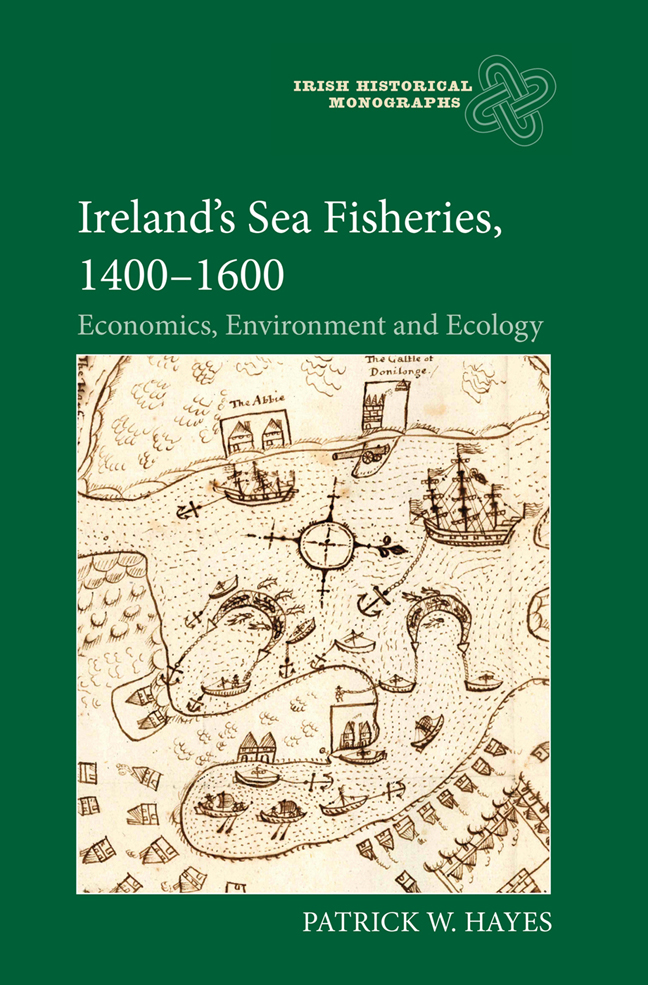46 results
1 - The Development of Fisheries, 1400–1500
-
- Book:
- Ireland's Sea Fisheries, 1400-1600
- Published by:
- Boydell & Brewer
- Published online:
- 22 February 2024
- Print publication:
- 12 December 2023, pp 16-46
-
- Chapter
- Export citation
Introduction
-
- Book:
- Ireland's Sea Fisheries, 1400-1600
- Published by:
- Boydell & Brewer
- Published online:
- 22 February 2024
- Print publication:
- 12 December 2023, pp 1-15
-
- Chapter
- Export citation
Dedication
-
- Book:
- Ireland's Sea Fisheries, 1400-1600
- Published by:
- Boydell & Brewer
- Published online:
- 22 February 2024
- Print publication:
- 12 December 2023, pp v-vi
-
- Chapter
- Export citation
Abbreviations
-
- Book:
- Ireland's Sea Fisheries, 1400-1600
- Published by:
- Boydell & Brewer
- Published online:
- 22 February 2024
- Print publication:
- 12 December 2023, pp xiii-xiv
-
- Chapter
- Export citation
Conclusion
-
- Book:
- Ireland's Sea Fisheries, 1400-1600
- Published by:
- Boydell & Brewer
- Published online:
- 22 February 2024
- Print publication:
- 12 December 2023, pp 248-254
-
- Chapter
- Export citation
3 - The Fish Trade
-
- Book:
- Ireland's Sea Fisheries, 1400-1600
- Published by:
- Boydell & Brewer
- Published online:
- 22 February 2024
- Print publication:
- 12 December 2023, pp 89-146
-
- Chapter
- Export citation
Index
-
- Book:
- Ireland's Sea Fisheries, 1400-1600
- Published by:
- Boydell & Brewer
- Published online:
- 22 February 2024
- Print publication:
- 12 December 2023, pp 294-312
-
- Chapter
- Export citation
6 - Oceanographic Variation and Environmental Change
-
- Book:
- Ireland's Sea Fisheries, 1400-1600
- Published by:
- Boydell & Brewer
- Published online:
- 22 February 2024
- Print publication:
- 12 December 2023, pp 223-247
-
- Chapter
- Export citation

Ireland's Sea Fisheries, 1400-1600
- Economics, Environment and Ecology
-
- Published by:
- Boydell & Brewer
- Published online:
- 22 February 2024
- Print publication:
- 12 December 2023
Miscellaneous Endmatter
-
- Book:
- Ireland's Sea Fisheries, 1400-1600
- Published by:
- Boydell & Brewer
- Published online:
- 22 February 2024
- Print publication:
- 12 December 2023, pp 313-314
-
- Chapter
- Export citation
List of Illustrations
-
- Book:
- Ireland's Sea Fisheries, 1400-1600
- Published by:
- Boydell & Brewer
- Published online:
- 22 February 2024
- Print publication:
- 12 December 2023, pp viii-xi
-
- Chapter
- Export citation
Contents
-
- Book:
- Ireland's Sea Fisheries, 1400-1600
- Published by:
- Boydell & Brewer
- Published online:
- 22 February 2024
- Print publication:
- 12 December 2023, pp vii-vii
-
- Chapter
- Export citation
Glossary of Fish Species
-
- Book:
- Ireland's Sea Fisheries, 1400-1600
- Published by:
- Boydell & Brewer
- Published online:
- 22 February 2024
- Print publication:
- 12 December 2023, pp xv-xvi
-
- Chapter
- Export citation
Frontmatter
-
- Book:
- Ireland's Sea Fisheries, 1400-1600
- Published by:
- Boydell & Brewer
- Published online:
- 22 February 2024
- Print publication:
- 12 December 2023, pp i-iv
-
- Chapter
- Export citation
4 - The Impact of War and Piracy
-
- Book:
- Ireland's Sea Fisheries, 1400-1600
- Published by:
- Boydell & Brewer
- Published online:
- 22 February 2024
- Print publication:
- 12 December 2023, pp 147-193
-
- Chapter
- Export citation
5 - Fish Consumption and Provisioning
-
- Book:
- Ireland's Sea Fisheries, 1400-1600
- Published by:
- Boydell & Brewer
- Published online:
- 22 February 2024
- Print publication:
- 12 December 2023, pp 194-222
-
- Chapter
- Export citation
Bibliography
-
- Book:
- Ireland's Sea Fisheries, 1400-1600
- Published by:
- Boydell & Brewer
- Published online:
- 22 February 2024
- Print publication:
- 12 December 2023, pp 266-293
-
- Chapter
- Export citation
2 - Diversity and Cooperation in Sixteenth-Century Fisheries
-
- Book:
- Ireland's Sea Fisheries, 1400-1600
- Published by:
- Boydell & Brewer
- Published online:
- 22 February 2024
- Print publication:
- 12 December 2023, pp 47-88
-
- Chapter
- Export citation
Appendices
-
- Book:
- Ireland's Sea Fisheries, 1400-1600
- Published by:
- Boydell & Brewer
- Published online:
- 22 February 2024
- Print publication:
- 12 December 2023, pp 255-265
-
- Chapter
- Export citation
Acknowledgements
-
- Book:
- Ireland's Sea Fisheries, 1400-1600
- Published by:
- Boydell & Brewer
- Published online:
- 22 February 2024
- Print publication:
- 12 December 2023, pp xii-xii
-
- Chapter
- Export citation



